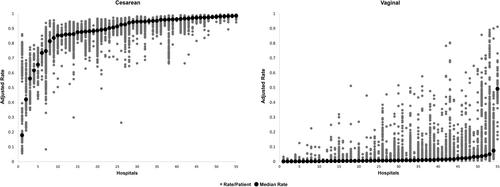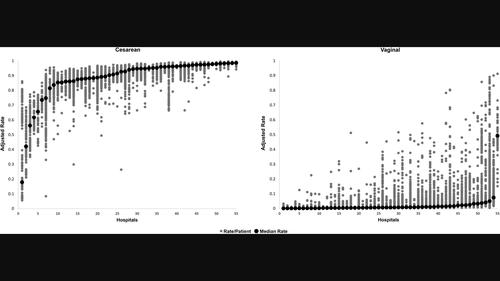Drivers of variation in postpartum opioid prescribing across hospitals participating in a statewide maternity care quality collaborative
Abstract
Background
We describe variation in postpartum opioid prescribing across a statewide quality collaborative and assess the proportion due to practitioner and hospital characteristics.
Methods
We assessed postpartum prescribing data from nulliparous, term, singleton, vertex births between January 2020 and June 2021 included in the clinical registry of a statewide obstetric quality collaborative funded by Blue Cross Blue Shield of Michigan. Data were summarized using descriptive statistics. Mixed effect logistic regression and linear models adjusted for patient characteristics and assessed practitioner- and hospital-level predictors of receiving a postpartum opioid prescription and prescription size. Relative contributions of practitioner and hospital characteristics were assessed using the intraclass correlation coefficient.
Results
Of 40,589 patients birthing at 68 hospitals, 3.0% (872/29,412) received an opioid prescription after vaginal birth and 87.8% (9812/11,177) received one after cesarean birth, with high variation across hospitals. In adjusted models, the strongest patient-level predictors of receiving a prescription were cesarean birth (aOR 899.1, 95% CI 752.8–1066.7) and third−/fourth-degree perineal laceration (aOR 25.7, 95% CI 17.4–37.9). Receiving care from a certified nurse-midwife (aOR 0.63, 95% CI 0.48–0.82) or family medicine physician (aOR 0.60, 95%CI 0.39–0.91) was associated with lower prescribing rates. Hospital-level predictors included receiving care at hospitals with <500 annual births (aOR 4.07, 95% CI 1.61–15.0). A positive safety culture was associated with lower prescribing rates (aOR 0.37, 95% CI 0.15–0.88). Much of the variation in postpartum prescribing was attributable to practitioners and hospitals (prescription receipt: practitioners 25.1%, hospitals 12.1%; prescription size: practitioners 5.4%, hospitals: 52.2%).
Discussion
Variation in postpartum opioid prescribing after birth is high and driven largely by practitioner- and hospital-level factors. Opioid stewardship efforts targeted at both the practitioner and hospital level may be effective for reducing opioid prescribing harms.



 求助内容:
求助内容: 应助结果提醒方式:
应助结果提醒方式:


